|
Section VII Memories Of Vietnam War 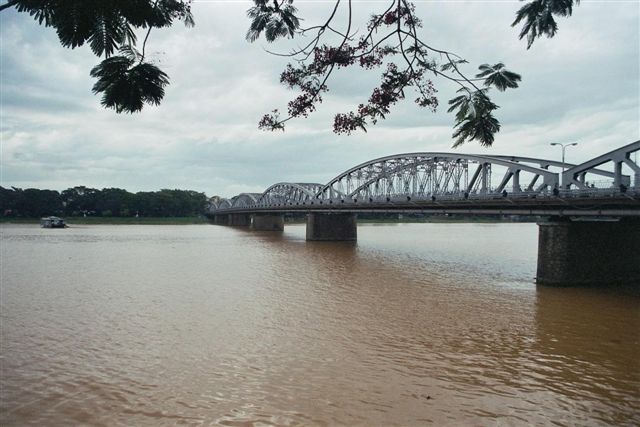 "TẾT MẬU THÂN OFFENSIVE" Year 1968 - Year of the Monkey After the Việt Cọng occupied Huế City, they ordered men and former government soldiers and personnel to report to their local committee to register then, they started searching to capture men and young men who were hiding from their authority, Because of the situation was getting worse I talked to my parents and my wife and decided to escape from our area to other side of the Perfume River where the Republic of Vietnam Army and U.S Marines still had been fighting and holding their positions. So, on early next morning, I said goodbye to my love ones and I went out by the rear door in the cold, down the dirt road, across my old aunt’s house, toward the main road to the Perfume River. As soon as I almost passed my Aunt’s house, I heard loud dogs’ barking and voices of people talking from not far away; I ran into my Aunt’s house and asked her to show me the hiding places. She led me to a low, dark handmade bunker in the back room and told me to get inside and to hide myself at the farest corner. About ten minutes, I heard the voices of Việt Cọng militias questioning my Aunt, Cô Thiệp who tried to span the blanket that she used to keep herself warm, across the small and low entrance of the bunker and asking if they wanted to have cups of tea. She intended to distract them from looking down to the bunker where she stood in front of its entrance. The Việt Cọng went to the living room up front and finally left the house after they apprehended two young students hiding over there. I waited for a moment then came out of the bunker and kissed my Aunt, Cô Thiệp to thank her for saving my life then deciding to get back to my parents’ house to meet my wife and my parents who were so nervous and worry and afraid if I got caught or not. Two days later, when hiding in the house, I was told by my wife that a girl in our neighborhood being lightly wounded at her right ankle. When she went to the riverbank of Perfume River to get drinking water and got hurt by warning shots shooting by Việt Cọng soldiers guarded there to stop people trying to escape to the South Vietnamese Forces stationed at the other side of the river. One of our relatives who was a medical student living nearby was treating the poor girl.
Two weeks went by without any search from the Việt Cọng, perhaps they were busy planning to withdraw from their positions according to the reports that I heard from my transistor radio while hiding in my hideouts.
On the night of 26th day of hiding, about 1100pm I was under ground in my hideout, I heard sounds of rockets coming from the other side of the Perfume River. Suddenly, the rockets hit our fruit trees in the back yard in the rear of my family’s house that was located in the compound Thoại Thái. My chest was hurting so bad. Then another rocket hit out side of the window above my hiding place, I could not continue to stay under ground any longer, therefore I must come up and rushed into the family’s bunker where everyone was taking cover. They all were happy and thought that I was coming back to rescue them... We were safe until next morning then as soon my father took a walk outside the house, he hurried back inside to inform everyone that he saw SVN Rangers on the way to rescue us. I wore my Navy uniform with my Lt rank on my shoulders and reported to the SVN Army Captain and told him that I requested to accompany his platoon to fight the Việt Cọng. The Capt handed me a rifle and told me to stay close to him. I said “goodbye” to my family and left with the platoon of SVN Rangers to search for and liberate people in all of our neighborhoods. Thanks to my parents, my Aunt, Cô Thiệp and my wife, Minh, I survived through that desperate and hopeless time of the Tết offensive until the South Vietnamese Rangers liberated our town. I was able to return to my unit in Đà Nẳng without my family, after 26 long days in the hideouts. Minh joined me in Đà Nẳng later to give birth to our fifth child, a girl; Thanh Nhã was born on April 1968. by Lê Bá Thông 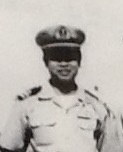
*****
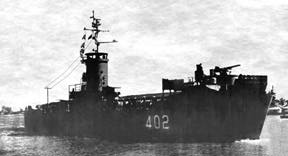 “The Waves of Love” (Chiến Dịch Sóng Tình Thương)
The duty of a warrior is to defend his country against the enemy and to safeguard the security and the safety of his family. Thus, the love for the family and to fulfill the responsibility for the country was the task and honor for a warrior.
The journey of destiny began after Ensign Lê Bá Thông graduated and was on-the-job-training duty on the USS Platte AO 24, a U.S Navy Fleet Oiler assigned to the Seventh Fleet in the Pacific Ocean. The Captain of USS Platte, an old sailor of the WWII era, a Navy Captain waiting to retire after 30 years of service had become Thông’s inspiration for his Navy life. The Captain told of his adventures when he served aboard warships operated in the Pacific Ocean during WWII and the Korean War. He recalled his dangerous tiger hunting trip with King Bảo Đại of Vietnam in the Ba Mê Thuộc jungle in the mountainous central highland of Vietnam. He also showed Ensign Thông a smoking pipe made from elephant tusk, a gift given to him from King Bảo Đại as a souvenir of his visit as part of the American diplomatic team.
Thông returned to Vietnam early after the USS Platte’s assignment was over and sailed back to his homeport at U.S Yokusuka Naval Base in Japan.
Lieutenant Khương Hữu Bá, Deputy Chief of Staff, a famous Captain of many SVN Navy ships, graduated from class 3 Vietnamese Academy at Nha Trang. He was also Commander of Navy forces on the first ever in Vietnam War amphibious operation “The Waves of Love” (Chiến Dịch Sóng Tình Thương) that would begin in January 1963 to pacify and destroy Việt Cọng’s controlled territory in the southernmost areas of Vietnam at Cà Mâu peninsular (Mũi Cà Mâu).
The operation forces consisted of two Marine Battalions, more than 10 Navy ships, two River Assault Groups, a UDT team, and the SVN Air Force all commanded by the Chief of Naval Operation, Captain Hồ Tấn Quyền and his Deputy, SVN Marine Corps Commandant, Lt Colonel Lê Nguyên Khang.
In December 1962, Ensign Lê Bá Thông left the ram of the Landing Ship Mechanized (LSM) HQ 402 under Navy gunfire support, to accompany the second wave of SVN Marines, landing on the muddy shore of Cà Mâu peninsula. 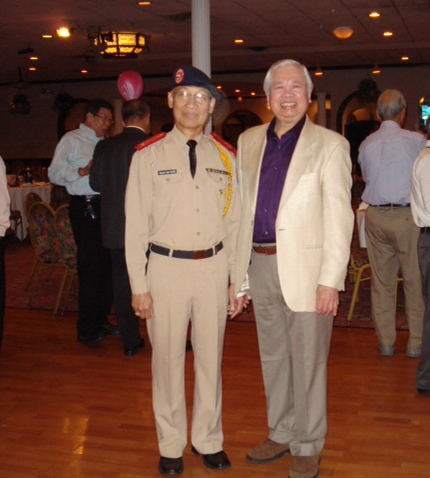
The Vietnamese National Military Academy Memory In early 1972, when the VNMA was named as the facilities provided training for Army, Air Force cadets and Navy midshipman, due to the bizarre arrangement of fate, a big event had happened in my military career. A great opportunity brought nicest memories and had changed not only the way of my thinking about the Vietnam War but even affects my faith, the idealism of a sailors with enthusiastic spirit to my country and her people.. In just over a year I served and worked with the young cadets of class 25, 26 and 27 of the Vietnamese National Military Academy, I felt a correlation, closely associated with the youth who preserved ideal altitude toward our country, loving motherland, and then only a few short months I was attracted to the "patriotic environment" because of the spiritual soul of our country. Twenty-seven years passed by like a dream, with the tragic changes happened to our beloved homeland Vietnam, like other refugees, I tried to forget the past, but each time when I am looking old pines at a lakeside on the trip in this second country, I once again remembered Da Lat City, and I missed my wonderful time at the Military Academy.
Deputy Commandant of the Military Instruction Directorate, a position previously only was held by infantry officers, but now it assigned to me and then gave me a lot of experiences in the life of a sailor who worked at the place on the Great Mountains, a treasure with precious memories and wonderful memories will live forever in my heart. I began translating into Vietnamese and typing a document written by my American friend. It was an article about the training program at the Vietnamese National Military Academy. The author was Colonel Edward Rowe Dorsey, the former Military Advisor for the Military Instruction Directorate in 1972-1973 and also later become my friend who was sponsor my family upon our arrival in the United States in 1975 until today. Colonel Rowe wrote this research in 1972 when he was a Major and was posted in the Association of Graduates Assembly, United States Military Academy, West Point and was published on March 1973 in the United States of America. I decided to translate into Vietnamese the article of Maj Rowe, as a reminder of wonderful memories, as spiritual gifts to send to former young cadets. I wish the former cadets of Da Lat Military Academy all the best, always keep their glorious tradition in mind and remember they are very lucky to have opportunity to become ones of the proudest family members of the Vietnamese National Military Academy, the famous school of the people of Vietnam...
The Republic of Vietnam Navy
by Commander Thong Ba Le The Vietnamese Navy was founded in 1952 with the Turn Over program from the French Navy, until August 20, 1955, the date that Vietnamese Naval Officers completely commanded the Navy Forces. There were about 2000 personnel from the beginning, with 22 vessels consisting of: Patrol Coastal Escort (PCE), Landing Ship, Mechanized (LSM), Landing Ship Infantry, Large (LSIL), Landing Ship Support, Large (LSSL), Mine Sweeper (YMS) and six River Assault Groups. The Navy then was formed into two main Combat Forces: Sea Forces and River Forces. In 1959, North Vietnamese Communists started developing a movement to sneak troops and equipment into the Republic of Vietnam’s territory. In order to stop the Communists from using the East Sea to sneak troops and weapons by boats to the coastline of South Vietnam, the RVN’s Navy, along with the mentioned ships, organized a Luc Luong Hai Thuyen (Coastal Junk Force) with 200 boats. These motor propelled and sail junk boats, manned by Regional Irregular Forces personnel and local fishermen recruited for the occasion, kept watch along the 1,200 mile coastline. The name Coastal Junk Force was later changed to Regular Forces and came to be known as Duyen doan (Coastal Groups) and was under the command of the Coastal Zones. While organizing the Coastal Junk Force, the Sea Force was also modernized and developed with the receiving of warships that were transferred from the United States Navy. The period between 1959 and 1966 was noted for the considerable advance of the RVN Navy in every field involved: the operations activities, the training facilities and the logistics capability. These fields had developed and improved as well as the overall organization and management of the Navy. The total number of gunboats, warships and junk boats increased from 94 units to 560 vessels and the number of personnel grew to 16,000 from 3,000 in 7 years. In addition, from October 1966, Luc Luong Lien doan Tuan Giang (The River Patrol Groups), previously under the command of Dia Phuong Quan (The Regional Irregular Forces), were included in the Command and the Organization of the Republic of Vietnam Navy.
2. The Navy Headquarters Organization The Vietnamese Navy Headquarters was the brain of the Republic of Vietnam Navy. It was responsible for the operation, management and development of the Navy and was divided into 8 prominent branches as follows: 
3. The Combat Forces The Combat Forces were important elements of the Navy that consisted of seven Zone Navy Headquarters and 9 different Forces as listed:
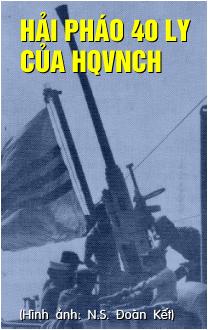
3.1 The 5 Coastal Zones In order to coordinate operations of the territorial and tactical organizations, there were 5 Coastal Zones established and named as First Coastal Zone, Second Coastal Zone and so on. Their primary responsibilities were to maintain the Seaboard and Coastal security including the island territory. Their other missions were to stop and prevent the enemy’s illegal infiltration by sea and to conduct operations of their naval units to support and reinforce the appropriate Army Tactical Corp. The main units of the Coastal Zones were Duyen doan (the Coastal Groups), Hai doi Duyen phong (the Coastal Patrol Maritime Groups), Dai Kiem Bao (Radar Surveillance Sites) and Can Cu Hai Quan (Naval Bases) located in their territories. Along the coast of the Republic of Vietnam, there were 20 Coastal Groups and 16 Radar Surveillance Sites; each Coastal Group was equipped with 12 motor-propelled junk boats of various types:
Each Coastal Patrol Maritime Group was manned with gunboats including Patrol Craft, Fast (PCF), "Swift" and WPB (former U.S. Coast Guard 82ft-patrol boat).
3.2 The Riverine Zone There were two Riverine Zones in the RVN Navy:
3.3 The National Capitol Special Zone The Naval Force that operated in the rivers surrounding the Nation Capitol Special Zone was responsible for security. It provided protection for the Capitol as well as coordinated the operations of all naval units in Saigon and its surrounding areas and provided administrative support to the Navy Headquarters.
3.4 The Rung Sat Special Zone The Vietnamese Navy was designated to be responsible for securing the traffic on the strategic and vital rivers that connected Saigon and the East Sea, the were Long Tao River and Soai Rap River. The Rung Sat Special Zone was covered with jungle of water plants that created ideal areas for VC guerrilla warfare; therefore it was difficult to protect and provide the safety to the thousands of merchant ships steaming in and out through these rivers. But the Navy Forces in charge of this task did a great job of securing the ships’ safety without incident in recent years.
3.5 The River Patrol Group The River Patrol Group, previously under the Command of the Regional Irregular Forces, was later assimilated into the Navy and consisted of 24 River Patrol Companies, 3 repair and maintenance Companies and a Training Center in Cat Lai. The companies were organized to provide operations support to their designated districts and secure the safety on rivers and waterways. They were manned with LCM-3 landing crafts and Harbor Patrol boats.
3.6 The Navy Fleet
Task Group I: All ships of Task Group I carried out the responsibility of patrolling in the Vietnamese territorial waters to stop the illegal infiltration of the enemy from the North and provided naval gunfire and support in combined operations with the friendly Forces. The Task Group I was manned with:
Task Group II: This Task Group provided transportation, amphibious operations, supplies, repair and maintenance to gunboats and gunfire support in the operations areas. Task Group II also carried out Medical assistance and Civilian psychological and political warfare programs with its two Hospital ships that were equipped with X-ray facilities; dental care units, labs and clinics. These two Hospital ships frequently visited villages located along the coast and rivers in the Mekong Delta to help people who lived in the concentrated area and need medical assistance due to the lack of medicine and medical facilities in their areas. Task Group II consisted of:
Task Group III: This Task Group patrolled in the open sea to discover and immediately stop the infiltration of the enemy and coordinated in combined operations and provided naval fire support to friendly forces. Task Group III was manned with:
3.7 The Amphibious Force The Amphibious Force was formed in June 1969 to replace the U.S. Task Force 117. This Task Force operated in Mekong Delta and consisted the following units: Command and Control Boat (CCB)
3.8 The River Patrol Force The River Patrol Force was founded in October 1969 and consisted of 14 River Patrol Groups, divided into 6 River Patrol Task Groups. Their primary responsibility was to patrol, to secure the safety of the rivers and to stop and prevent the infiltration of the VC through the Task Force’s responsible areas from the border of Cambodia and Vietnam. Each River Patrol Group was manned with Patrol Fast Boats (PBR), which had very high speeds and the capability to go into narrow creeks and shallow waters and were very easy to maneuver.
3.9 The Special Mission Force With the concept of using a variety of units to operate in a combined territory to carry out special missions, the Task Group was manned with the following groups:
3.10 The Marines Corps The Republic of Vietnam Marines Corps had been organized into Divisions, and although they were in the Organization of the Navy, they were still placed as part of the Reserved Forces of the General Headquarters of Vietnamese Arms Forces.
3.11 The Coastal Security Service
4. Operational Command and Control To be more effective in conducting naval operations, the Navy Combat Units were placed under the Operational Command and Control of The Tactical Mobile Riverine Headquarters and the Tactical Mobile Sea Headquarters.
4.1 The Tactical Mobile Riverine Headquarters The headquarters commanded and controlled the operations in rivers located in the territories of The Army III Corps, The Army IV Corps and The Nation Capitol Special Zone to stop and prevent the enemy’s sneaking of troops and supplies and to secure the safety of the waterways and to support the Army Divisions in operations Tran Hung Dao 36,41,43,44.
4.2 The Tactical Mobile Sea Headquarters In order to effectively maintain control over the entire Republic of Vietnam territorial waters, the Tactical Mobile Sea Headquarters was established to command and to control maritime operations Tran Hung Dao along the coastline and to stop and prevent the infiltration of the North Vietnamese Communists by boats. The Organization also provided naval gunfire support to friendly forces in the responsible operational areas and to assist in the Pacification programs of the Government. There were 5 Sea Operations Zones and each zone was controlled by a Task Force and manned with about 100 ships, gunboats and junk boats. The Sea Operations Zone consisted of three tactical areas:
5. Logistics The Logistics Command Headquarters supported the logistics and supplies to the Naval operational units. The following facilities were placed under the management of the Logistics Command:
6. Training There were 3 Training Centers in the Vietnamese Navy; they were located at Nha Trang, Cam Ranh Bay and Saigon:
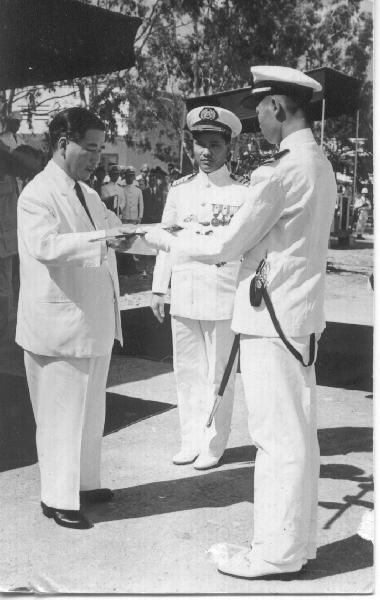
There was also the Cat Lai Training Center of the River Patrol Group that was used to train Non-Commissioned Officers, Specialty Programs and Supply School.
From November 1966 to January 1973, the Republic of Vietnam Navy successfully achieved the following victories in combat:
Weapons captured: 382 big guns and 2851 individual weapons. The RVN Navy also sank and captured 467 VC junk boats and destroyed 14 North Vietnamese ships that infiltrated to the South Vietnam on the following places and dates:
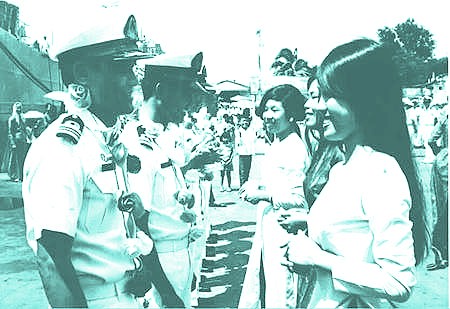
The Communists violated the Cease Fire Agreement: In February, 1973 the Cease Fire Agreement, signed by the North Vietnam Communists on January 27, 1973 in Paris to reestablish peace for Vietnam, was violated by the Communists. They attacked units of the RVN Arms Forces and Naval vessels. The 827 violations to the Navy included 575 attacks, 155 bombardments and 97 mine traps. In order to defend themselves, Naval units killed 63 North Vietnam Communists, captured 16 VC and 57 individual rifles and destroyed hundreds of mines and grenades
The Naval Battle of Paracels Island: On January 19, 1974, the Republic of Vietnam Navy ships courageously fought against the aggression of the Chinese Communists who tried to occupy the Paracels Island by force. The valiant and heroic action of the Officers and Enlisted men of the RVN Navy showed the spirit of our Navy’s Founder Tran Hung Dao and the patriotic quest of Vietnamese people. 
The Last Battle The sky was filled with bright stars above, the crescent moon hung in the southern part of the dark sky, streaming pale beams from the universe. The end-of-spring wind from the river softly blew the dark mane of a 34-year-old man who looked older than his age. I had grown up through the war, witnessing and engaging in many historical events of my country, especially in the past few months. I was the witness of the changes of life in people who had reversed their belief to the point that I could not imagine and made me wonder so much of the perspective in life. When I arrived at the operation center, I was informed that it was calm on all fronts and the Regional force had three battalions scattering around Rung Sat Special Tactical zone. They had been under enemy rocket attack but without any serious damage. Based on my experience, I knew that the Communist would launch their attack after midnight and continue until 6 o’clock in the morning. They would have 6 hours to fight before dawn. As I predicted, it was about 11:45 PM when I heard the gunshots come closer from the direction of the Nha Be fuel depots. Then before a new day began, a 122-millimeter rocket, then a second, a third started falling everywhere and exploded when they hit targets in the base. The village located just outside of the Naval Base was hit and burned in vigorous flames. Two rockets fell onto two guarded posts and destroyed them. The enemy continued bombarding important locations of the base with rocket after rocket damaging the two helicopters, destroying the ammunition storage, the airfield runway, and warehouses. I led a platoon of sailors to re-enforce the defense of the rear front. We were running under the roar of rockets that were falling around. One sailor, just released from the prison, took off his helmet and handed it to his bareheaded Commanding officer. I thanked him but refused to take it. We continued on our route to the defended post near the fence. When we heard the terrible noise of rockets falling, we ducked on the ground, waited, then got up on our feet and ran again. From time to time, there were explosions so close that dirt and rocks covered our faces and heads. Normally it took about 10 minutes to travel from the operation center to this post; now it seemed like forever. Twenty minutes had passed but we had not yet reached the fence. Finally, we arrived at the post. This was a strong defended post with heavy armed artillery such as 12.7 millimeters machine guns, M79 grenade launchers, and communication equipment. From here, I could observe the whole area behind the base and toward the civilian village. I assessed and evaluated the situation here then decided to evacuate lightly injured personnel to the base hospital. The other posts reported the damage; beside the destruction caused by enemy rockets to warehouses, ammunition storage, only a few personnel were lightly injured, no fatal casualties were reported so far. The enemy only bombarded off and on and it seemed that they had not begun to launch ground attack. Perhaps they were waiting to regroup before sending their massive offensive attack or maybe they just wanted to scare the defender by bombarding them with rockets and destroying everything in the base as they did with other units in the Center of Vietnam. I predicted that the enemy would continue bombarding even heavier until daybreak. I radioed to the operation center and was notified by my officers that all units located in the Rung Sat Special Tactical Zone were also under enemy attack either by rockets or by ground forces. Some units suffered heavy casualties. One front was over-run and was trying to open an escape route toward the riverside. Enemy units, who were now moving along the riverbank and advancing to Nha Be fuel depot, occupied the Cat Lai Naval Base. Gunboats of the River Assault Group were shooting to stop the enemy with their naval firepower. There were a few boats being hit by B40, the Russian rocket launcher, and under fire. I decided to return to the Control and Command center with some sailors. While running across the airfield, at about 2 o’clock in the morning of April 30, 1975, I was surrounded by all kinds of gunshots and artillery sound. With explosions so loud, they reminded me of the 1968 Tet offensive event in Hue when I had to hide under ground for almost 28 days in the enemy controlled sector of the city. There were rockets falling around me while my mind was occupied with the previous experiences. The rockets fell and destroyed camps, houses and caused large fires everywhere. The fire engine and damaged control personnel were trying to extinguish as much as they could under the danger of being killed by falling rockets from the sky. Then at about 3 AM, there were rounds of rockets, one after another, precisely hitting important targets of my Naval Base as though being guided by the unknown internal artillery controller. I knew that the enemy had increased its pressure upon my defense. The left front reported being hit. They requested me to evacuate and withdraw. I complied with their request, but suddenly, all power was cut off. Lights went out, cable radios were interrupted, and communications between me and the units were terminated. Realizing that rockets had just destroyed the main generator house, I called all units from PRC-25 and ordered all hands to pull back and withdraw aboard boats that were ready at the pier to go out off shore. I then accompanied my staff members who carried maps and encoded materials and got aboard the Command and Control armed gunboat of the River Amphibious Group. The withdrawal to the boats under enemy gunfire and the embarking lasted about an hour without incident. My troupe then joined the naval units of the River Assault Group and deployed along the river to fight back enemy who were shooting from Thanh Tuy Ha side. Gunshots from big and small weapons were so noisy in the darkness of a cool night. Tracer bullets drew multiple tracks in all directions then exploded when they hit the unknown targets on both shoresof Nha Be River. Flares illuminated the sky like fireworks displayed in an official national holiday. 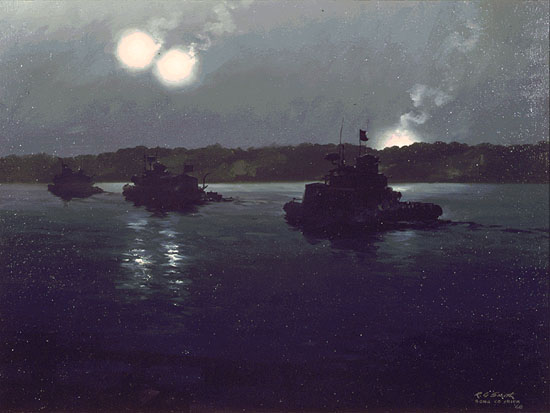
The sound from communicating radios mixing with the noisy gunshots, the yelling of crews of boats being hit by bullets had created a scene of war like one seen in a movie. The enemy was surprised to meet such a strong defense from the small units of courageous South Vietnamese Navy here, at the last eastern front. The battle continued until daybreak then slowly ceased; one could only hear a few wayward gunshots from the distance. The enemy finally stopped bombarding and they withdrew toward the direction of Thanh Tuy Ha ammunition depot. I radioed to the ambushed platoon leader who was still holding the front when all units withdrew at 0300 hours. The Ensign reported that the base was intact and the enemy did not send ground troops to attack the base. I informed the Commanding officer of the River Assault Group that I would return to the base with all personnel to re-group before the enemy could launch another round of attack. My command gunboat got alongside the pier in front of the Naval Base headquarters at 0700 hours on April 30, 1975...
|
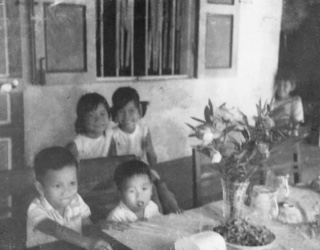
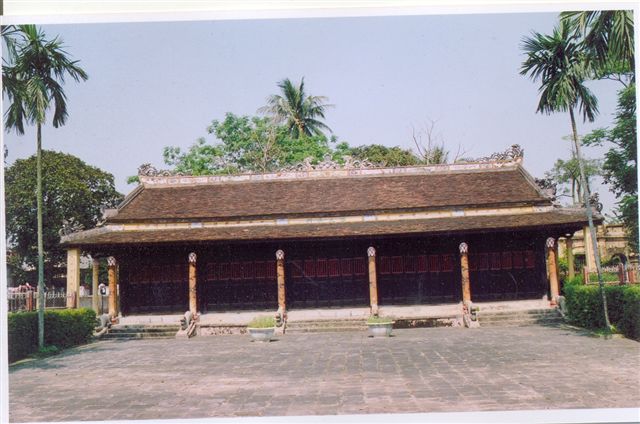
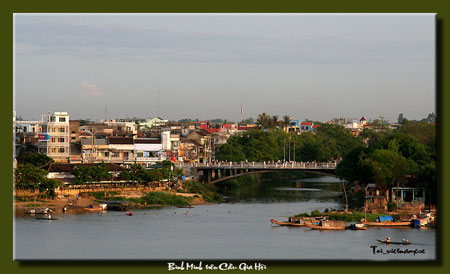
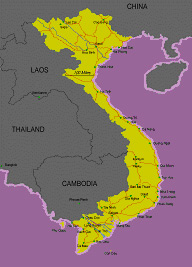


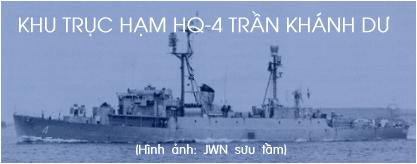 The Vietnamese Fleet was the main force of the Navy, consisting of warships with capabilities to operate in the open sea. The Vietnamese Fleet was divided into three Task Groups: Task Group I, Task Group II and Task Group III.
The Vietnamese Fleet was the main force of the Navy, consisting of warships with capabilities to operate in the open sea. The Vietnamese Fleet was divided into three Task Groups: Task Group I, Task Group II and Task Group III.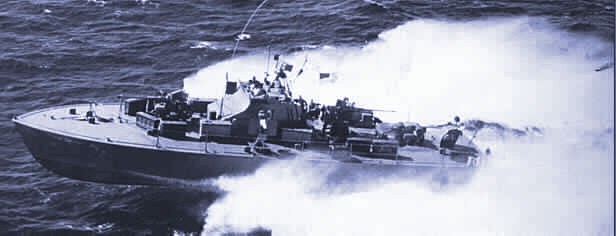 The Coastal Security Service was an organization of the Navy that was placed under the operational command of Nha Ky Thuat (The Strategic Technical Directorate or STD) to carry out special maritime missions along the coastline of Vietnam.
The Coastal Security Service was an organization of the Navy that was placed under the operational command of Nha Ky Thuat (The Strategic Technical Directorate or STD) to carry out special maritime missions along the coastline of Vietnam.